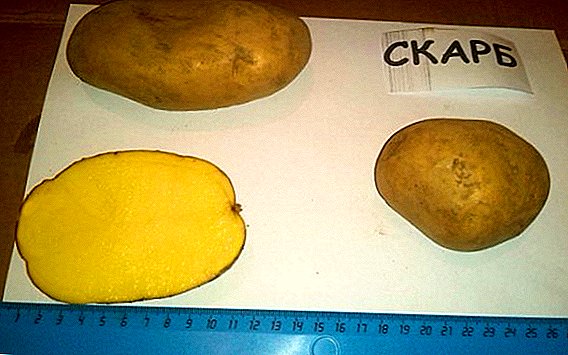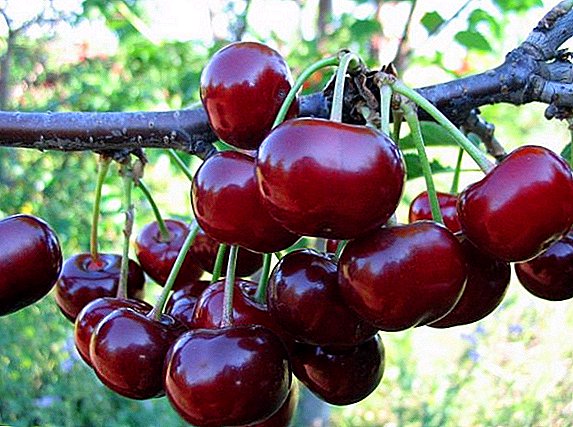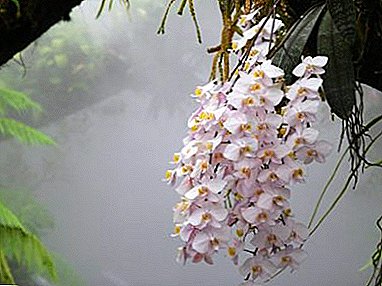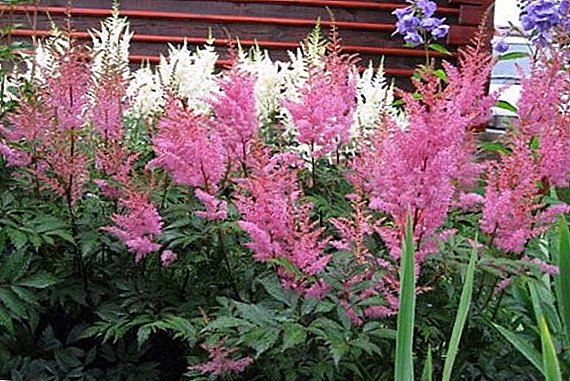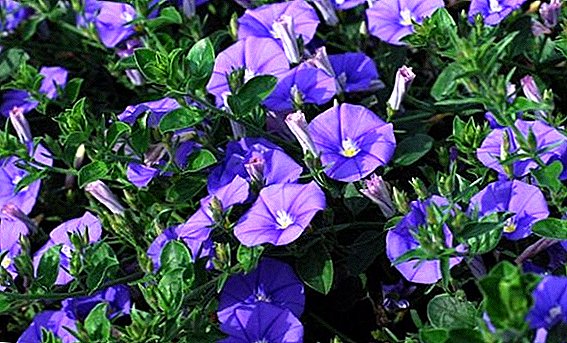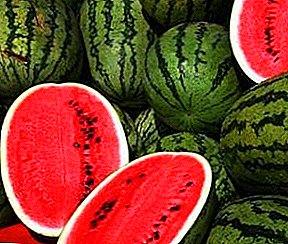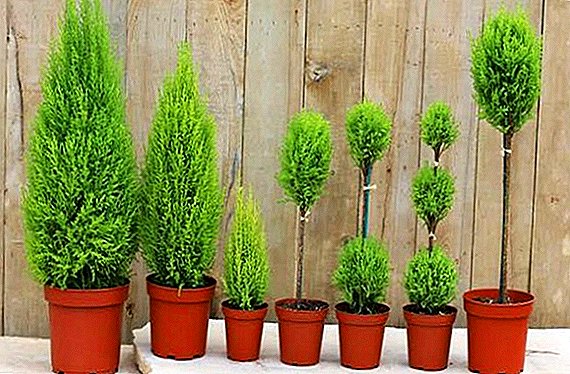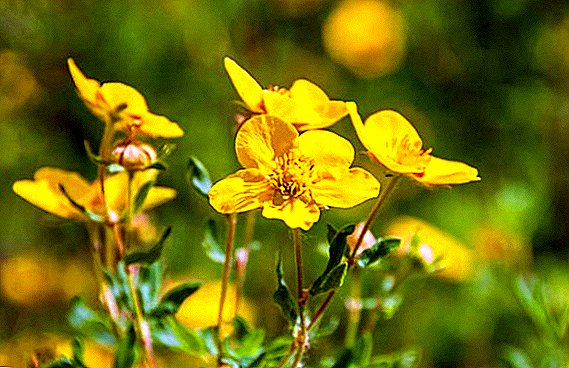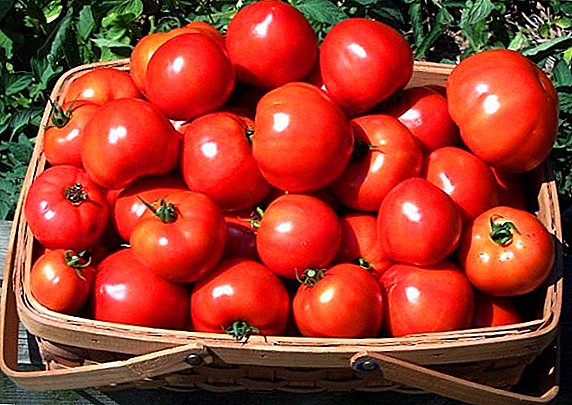 Tomatoes have long been popular in our gardens, have become one of the most used in culinary culture. Residents of the northern regions of the country face problems in cultivation: the Urals and Siberia, since tomatoes are a southern culture. Breeding does not stand still, and for the residents of the harsh regions, the new Snegir variety, resistant to low temperatures, has been developed, and we will talk about it in this article.
Tomatoes have long been popular in our gardens, have become one of the most used in culinary culture. Residents of the northern regions of the country face problems in cultivation: the Urals and Siberia, since tomatoes are a southern culture. Breeding does not stand still, and for the residents of the harsh regions, the new Snegir variety, resistant to low temperatures, has been developed, and we will talk about it in this article.
Variety description
"Bullfinch" - a short tomato, not standard, but not more than half a meter does not grow even under the most favorable conditions, which distinguishes it from other tomatoes of this type. Bush is not too branched, which facilitates the care of him. Strong pubescent shoots of light green color with not large, elongated shape carved foliage, covered with a soft pile from the bottom.
Another significant difference from many tomatoes is that shoots are able to survive not only low temperatures, but also return frosts; moreover, the variety does not lose the yield qualities on poor soils and under adverse conditions, such as lack of lighting or moisture. In the north-west, in open-field conditions, the crop ripens in July, and these are bushes grown without shelter.  The main advantages of the variety:
The main advantages of the variety:
- early and uniform ripening of fruits;
- resistance to temperature extremes and drought;
- resistance to diseases of the nightshade (late blight, brown spotting);
- ability to go without pinching;
- high quality of the crop;
- excellent transportation and storage of fruits;
- universality in application.
Did you know? Tomatoes are able to cheer up - the fruit contains happiness hormone serotonin, most of the substance is found in red varieties.
Fruit characteristics and yield
Fruits of the correct round form, in a period of full maturity are uniformly painted in dark red. The flesh is fleshy, not watery, but juicy, sweetish in taste, the fruit has five nests with a moderate amount of seeds. 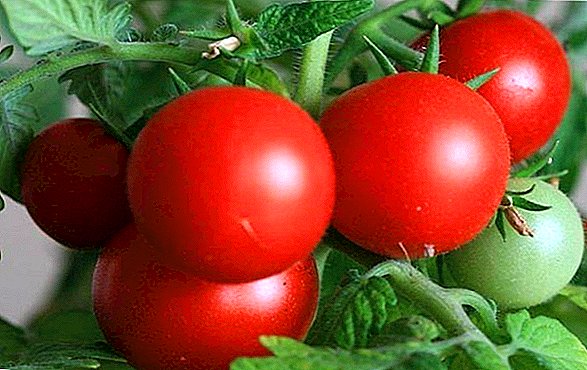 Early variety, ripens within 95 days after the appearance of the first shoots, during the formation of two trunks, six brushes with three to five fruits per hand ripen. The average weight of a tomato is 150 g. Up to 6.5 kg of crop can be harvested per square meter of planting.
Early variety, ripens within 95 days after the appearance of the first shoots, during the formation of two trunks, six brushes with three to five fruits per hand ripen. The average weight of a tomato is 150 g. Up to 6.5 kg of crop can be harvested per square meter of planting.
Selection of seedlings
Criteria for choosing a good seedling:
- the thickness of the stem is about a pencil;
- availability of seven to eight sheets;
- the presence of a strong brush;
- bright color of existing foliage, without yellowness or spots;
- lack of ovaries.
You will be interested to know how to choose the optimal time for planting tomato seedlings.
The bush, abundantly covered with leaves, is likely to be overfed with nitrogen, such seedlings will be reluctant to give ovaries, all the power will be used to build up the green mass. Too thick or too thin weak shoots are not equally acceptable.  If there are formed ovaries, there is no guarantee that the seedlings will take root. Even if it takes root, one will have to wait for the formation of already new ovaries, and, accordingly, the dates of fruiting will be postponed.
If there are formed ovaries, there is no guarantee that the seedlings will take root. Even if it takes root, one will have to wait for the formation of already new ovaries, and, accordingly, the dates of fruiting will be postponed.
You should not buy seedlings that are densely packed in a container: when the bushes are divided, there is a high probability of damaging the root system.
Important! Try to buy all the seedlings from one seller: the flora of the soil from each gardener has its own, the greater the number of sellers, the more "chances" to collect a bouquet of fungi.
Soil and fertilizer
Tomatoes need a nutrient, loose soil with a neutral reaction (pH 6), on acidic soils, the quality of fruiting is reduced. Ideal loamy and sandy soil. Planted seedlings when the soil is well heated, around June, the dates may vary depending on the region.  Determination of soil acidity using special devices
Determination of soil acidity using special devices
We advise you to consider the importance of soil acidity for plants, how to determine the acidity of the soil and how to deoxidize the soil.
Peas, beans, cabbage can be predecessors for tomatoes. It should not be planted after other solanaceous, including tomatoes. The earth is thoroughly cleaned of plant residues, dug up and fed with humus.
Growing conditions
At this time, the average air temperature in the north-western regions is + 15 ... +17 degrees, so for the first time it is better to cover the seedlings with a film for better adaptation. From time to time, remove the shelter to ventilate the plant and remove condensate from the film. In more comfortable conditions, you can do without the film.
For tomatoes, you need to pick up the illuminated area, but a small shadow "Bullfinch" does not hurt. Water the seedlings moderately, make sure that on the surface of the soil around the trunks did not form a crust.  After rooting, the film is removed and taken care of as an adult plant: moderate watering, fertilizing with mineral complexes during the flowering period, organic matter during fruiting.
After rooting, the film is removed and taken care of as an adult plant: moderate watering, fertilizing with mineral complexes during the flowering period, organic matter during fruiting.
Growing from seed to seedlings at home
The best method of growing tomatoes "Bullfinch" - is to grow seedlings yourself.
Seed preparation
Planting material needs pretreatment. To do this, prepare thawed or rainwater (it is softer than tap water), it is heated, but not boiled. In hot, about 50-60 degrees water, pour out the seeds, mix and reject all surfaced: they are pacifiers.  Preparing the seeds The next stage of preparation is soaking, in the cooled water (the seeds are not removed) add a growth stimulator, for example, "Appin" or "Silk". After three hours, the material is removed from the water and dried thoroughly.
Preparing the seeds The next stage of preparation is soaking, in the cooled water (the seeds are not removed) add a growth stimulator, for example, "Appin" or "Silk". After three hours, the material is removed from the water and dried thoroughly.
Content and location
For seeds, prepare containers or boxes for seedlings, prepare soil mixture. The best option: an equal amount of garden soil and humus are mixed and approximately half the river sand is added. It is desirable to ignite the soil.
For containers with crops prepare a warm place (+25 degrees) content with ambient lighting. On the lit place expose when shoots. 
Seed planting process
Sowing dates for early varieties - mid-March or the end of the month. Seeds are sown in the furrows, buried by 2 cm, sprinkled with soil. After sowing, the soil is moistened with a spray bottle. Do not pour water onto the soil from the watering can - wash the soil with the seeds.
Consider in more detail all the features of the germination of tomato seeds and their planting in the soil.
Seedling care
After the emergence of seedlings seedlings need bright light most of the day, so the plants need to illuminate. When the first pair of leaflets appears, the seedlings swoop into separate containers, discarding weak sprouts. After planting, fertilize complex mineral fertilizer with a predominance of nitrogen, which will accelerate the growth of greenery and shoots. Water moderately so as not to cause rotting of the roots.
About a week before planting in open ground, pots with bushes are carried out to the veranda or balcony for hardening. Begin the procedure with an hour or two, gradually increasing the content in the cool for a whole day.  Pots with bushes bring to the balcony for hardening
Pots with bushes bring to the balcony for hardening
Transplanting seedlings to ground
In June, seedlings are transplanted to a previously prepared area. The wells are shallow, accommodating the root system of the seedling. In order not to damage the tender roots of the seedlings and easily pull it out with a soil clod, the pot with a bush is watered. At the bottom of the pits piled a hill of land, put the seedlings, straighten the roots and fall asleep soil. Between plants, a distance of at least 40 cm, between rows of plantings - about 70 cm.
Agricultural technology of growing tomato seeds in the open ground
If we take into account the excellent frost resistance of the variety “Bullfinch”, then it is quite possible to plant it immediately with seeds.
Did you know? Every year around 60 million tons of tomatoes are grown in the world. For comparison: apples are grown about 36 million tons.
Outdoor conditions
For planting in open ground, you should choose the southern place on the site, open to the sun most of the daylight hours and closed from the wind. In the greenhouse you need to consider that the first time before germination the temperature of the content should be high - up to 25 degrees. After the emergence of shoots it should be lowered to 17-20 degrees.  When planted in the ground, the bushes are naturally quenched. Greenhouse planting will need to be hardened, leaving the door open for a while. The main disadvantage of growing in a greenhouse is the ideal conditions for insects and many fungal bacteria, warm and humid.
When planted in the ground, the bushes are naturally quenched. Greenhouse planting will need to be hardened, leaving the door open for a while. The main disadvantage of growing in a greenhouse is the ideal conditions for insects and many fungal bacteria, warm and humid.
Familiarize yourself with the following tomato cultivation methods: on the windowsill, in hydroponics, in the cochlea, according to the method of Maslov and Terekhins.
The process of planting seeds in the ground
Land for sowing in the ground is prepared in the fall, dug up with the introduction of humus and wood ash. Sowing is carried out at the end of March, in the northern regions in late winter they cover crops with a double film cover.
In the area chosen for sowing, shallow grooves are made, they are watered well and they wait until moisture is absorbed. Then sprinkle on one seed, not making a large distance between them. Then, when germinating, weak seedlings thin out. 
Watering
Watering tomatoes need a moderate, "Bullfinch" does not like excessive moisture, so with regular rainfall irrigation is carried out only when there is a clear need.
Familiarize yourself with the advantages of using drip irrigation, as well as learn how to organize a system of drip irrigation at the dacha.
For irrigation use warm, soft water, it is best to install on the site capacity for collecting rainwater. Tap water with strong hardness can be softened with borax or wood ash (3 g per 1 liter). 
Soil loosening and weeding
Simultaneously with irrigation, loosening is carried out to saturate the root system with oxygen. Weeding is carried out regularly, as necessary, removing weeds.
Masking
"Bullfinch" - a determinant grade, it means that, reaching a certain height, the tip stops growing and branching. Therefore, a variety, in principle, does not need pasynkovanii, by the way, small stepchildren also produce a crop. Form a bush in two or three trunks.
To increase the yield of tomatoes they need to stepchild. Read how to properly form tomato bushes in the open field and in the greenhouse.
Garter
The undersized variety, rather, needs support during the fruiting period, despite the thick shoots, heavy brushes with fruits can break them. Therefore, during the formation of fruits for the bush they prepare a small peg with its growth, tying up the bush with eight using thin string. 
No matter how strong the stalk may be, all gardeners recommend gartering tomatoes in the open field.
Top dressing
"Bullfinch" responds best to mineral supplements. During flowering, formation of ovaries and fruiting bushes are watered under the root of phosphorus-potassium complexes.
Pests, diseases and prevention
The main diseases of tomatoes are late blight, gray and top rot, brown leaf spot. "Bullfinch" has a strong immunity to these diseases, but prevention does not hurt.
Learn how to get rid of phytophthora, cladosporia and apical rot of tomatoes.
To prevent the development of fungi and viruses, the soil on the site is sprayed with a solution of potassium permanganate. Spraying is carried out with a hot solution of light pink color.  Spray the tomatoes with a solution of potassium permanganate. Before flowering, the plants are sprayed with the biological preparation "Fitosporin". Pests are destroyed with insecticides before the flowering period. Tomatoes can attack aphid, scoop, Colorado potato beetle, medvedka. When choosing insecticides should prefer a broad-spectrum drug. After flowering and during fruiting, you can use traditional methods:
Spray the tomatoes with a solution of potassium permanganate. Before flowering, the plants are sprayed with the biological preparation "Fitosporin". Pests are destroyed with insecticides before the flowering period. Tomatoes can attack aphid, scoop, Colorado potato beetle, medvedka. When choosing insecticides should prefer a broad-spectrum drug. After flowering and during fruiting, you can use traditional methods:
- infusion of dandelion roots;
- broth celandine;
- infusion of tansy;
- dusting with ashes and tobacco powder.
Important! Carry out the procedure in the evening, so that the moisture is absorbed gradually, and not evaporated under the sun and not burned in case of contact with the foliage.
Harvesting and storage
Crop ripens by mid - end of July. Fruits ripen almost evenly, so you can immediately remove the entire crop. Removed from the bush in a state of technical ripeness, if the tomatoes are grown for commercial purposes, and they will be transported. For home use can be removed and fully mature, since the culture is not prone to cracking.  For long-term storage, the fruits are folded in boxes, interbedded with sawdust, and the fruit is selected without any damage and dark spots. Storage temperature - 10-12 degrees, humidity - no more than 80%. The room is regularly aired so that moisture does not accumulate and fungal infections do not develop.
For long-term storage, the fruits are folded in boxes, interbedded with sawdust, and the fruit is selected without any damage and dark spots. Storage temperature - 10-12 degrees, humidity - no more than 80%. The room is regularly aired so that moisture does not accumulate and fungal infections do not develop.
At observance of these rules the product will remain about two months. Wash the product immediately before use.
Possible problems and recommendations
In order to avoid problems when growing crops, such as twisting or yellowing of leaves, dropping of ovaries or green fruits, preventive measures to combat diseases and pests should be carried out in time. It is to the defeat of infection, fungi or pests that the plant reacts with external manifestations.  Watering of plants should be carried out under the root to avoid burns of foliage. The amount of moisture should be moderate so as not to cause root rot, which, in turn, will affect the condition of the aerial parts. The lower leaves of the bushes should be cut off to avoid high humidity.
Watering of plants should be carried out under the root to avoid burns of foliage. The amount of moisture should be moderate so as not to cause root rot, which, in turn, will affect the condition of the aerial parts. The lower leaves of the bushes should be cut off to avoid high humidity.
It is not necessary to overdo it with nitrogen fertilizers and top dressing in general, the variety is adapted for development on poor soils, and with an abundance of fertilizers the terms of fruiting may move back, the quality of the crop will worsen, for example, the fruit will become watery and tasteless.  Dropping color will help avoid treatment with a solution of boric acid (slightly concentrated). And the fall of the ovaries will stop the stimulator "Bud." The solutions are sprayed with the culture in the evening, in dry, calm weather.
Dropping color will help avoid treatment with a solution of boric acid (slightly concentrated). And the fall of the ovaries will stop the stimulator "Bud." The solutions are sprayed with the culture in the evening, in dry, calm weather.
"Bullfinch" - a worthy representative of the early varieties of tomatoes. No feedback was found, and you can add one more to the above advantages: you can use these tomatoes fresh and preserve for the winter, pickle, pickle, sour, make juices and even jam from them.


